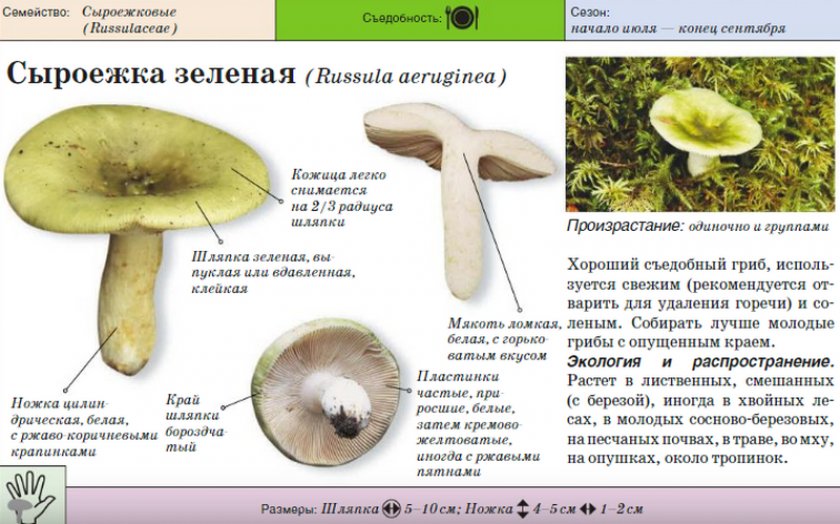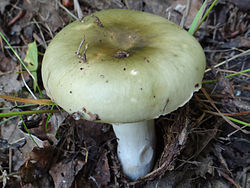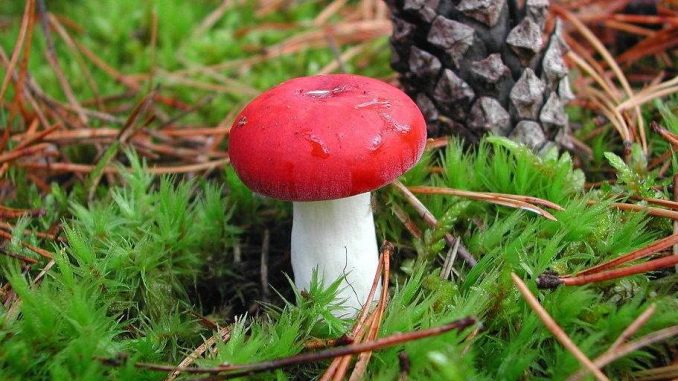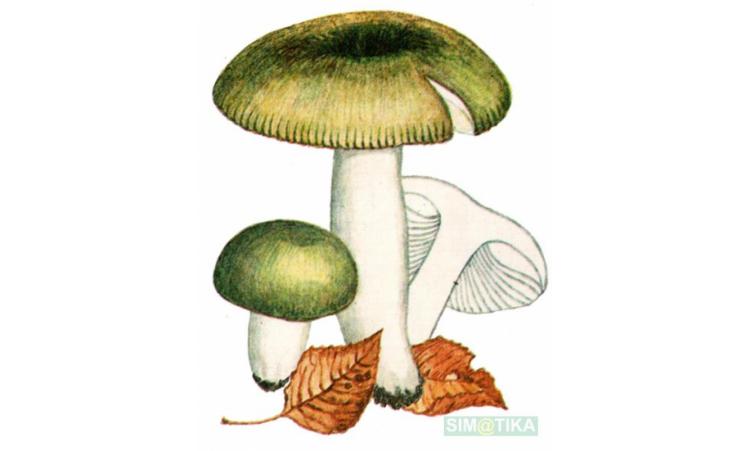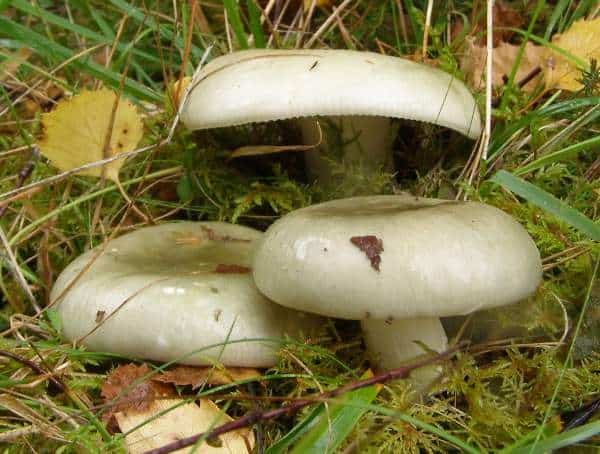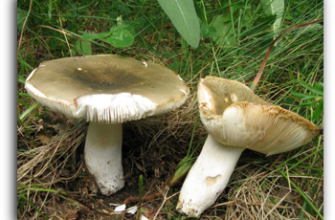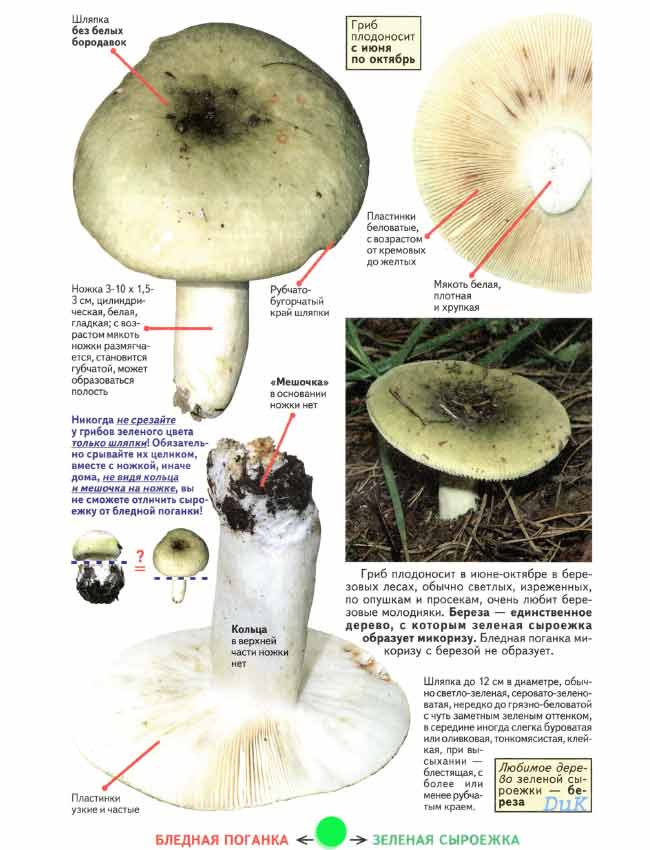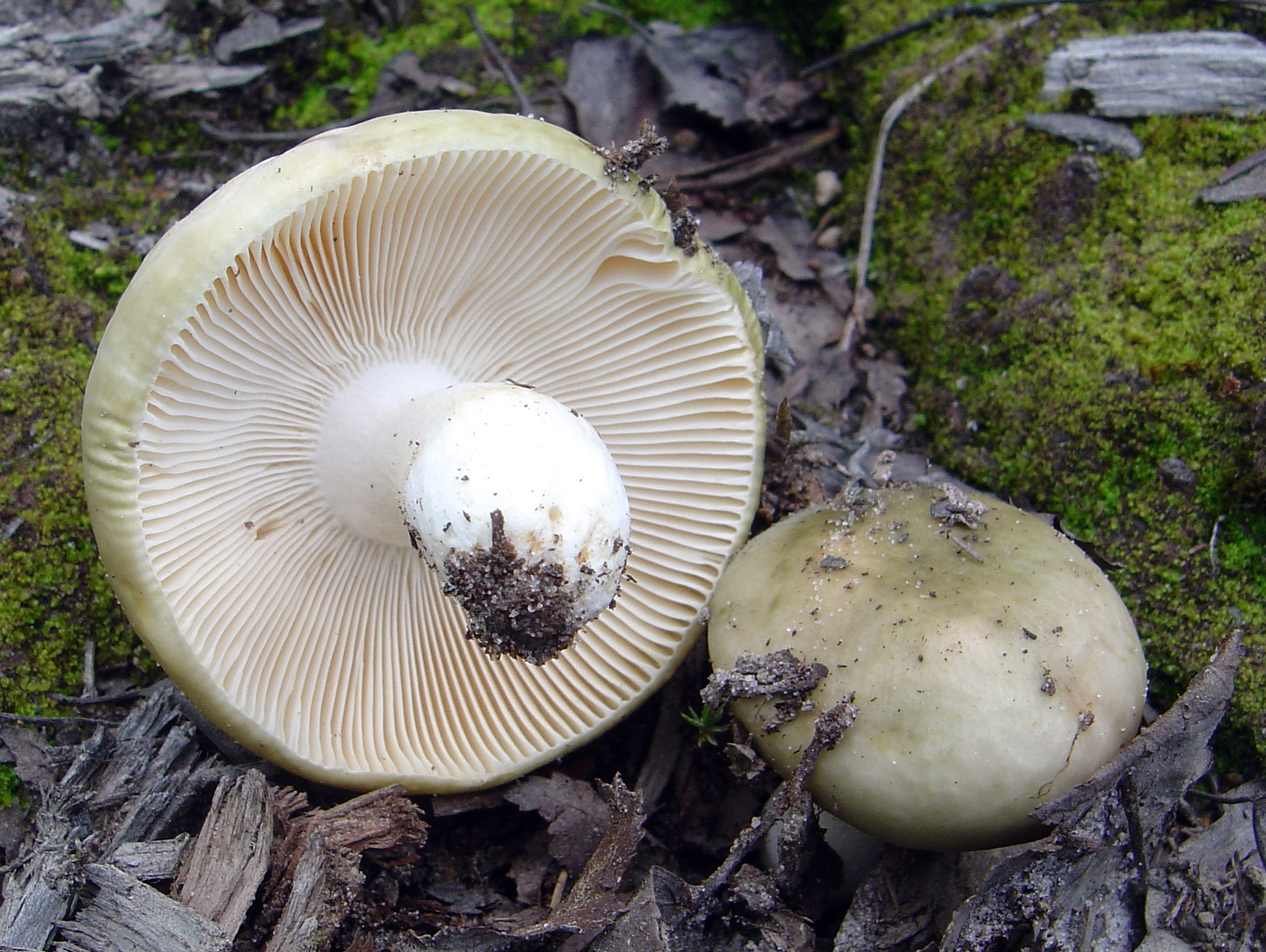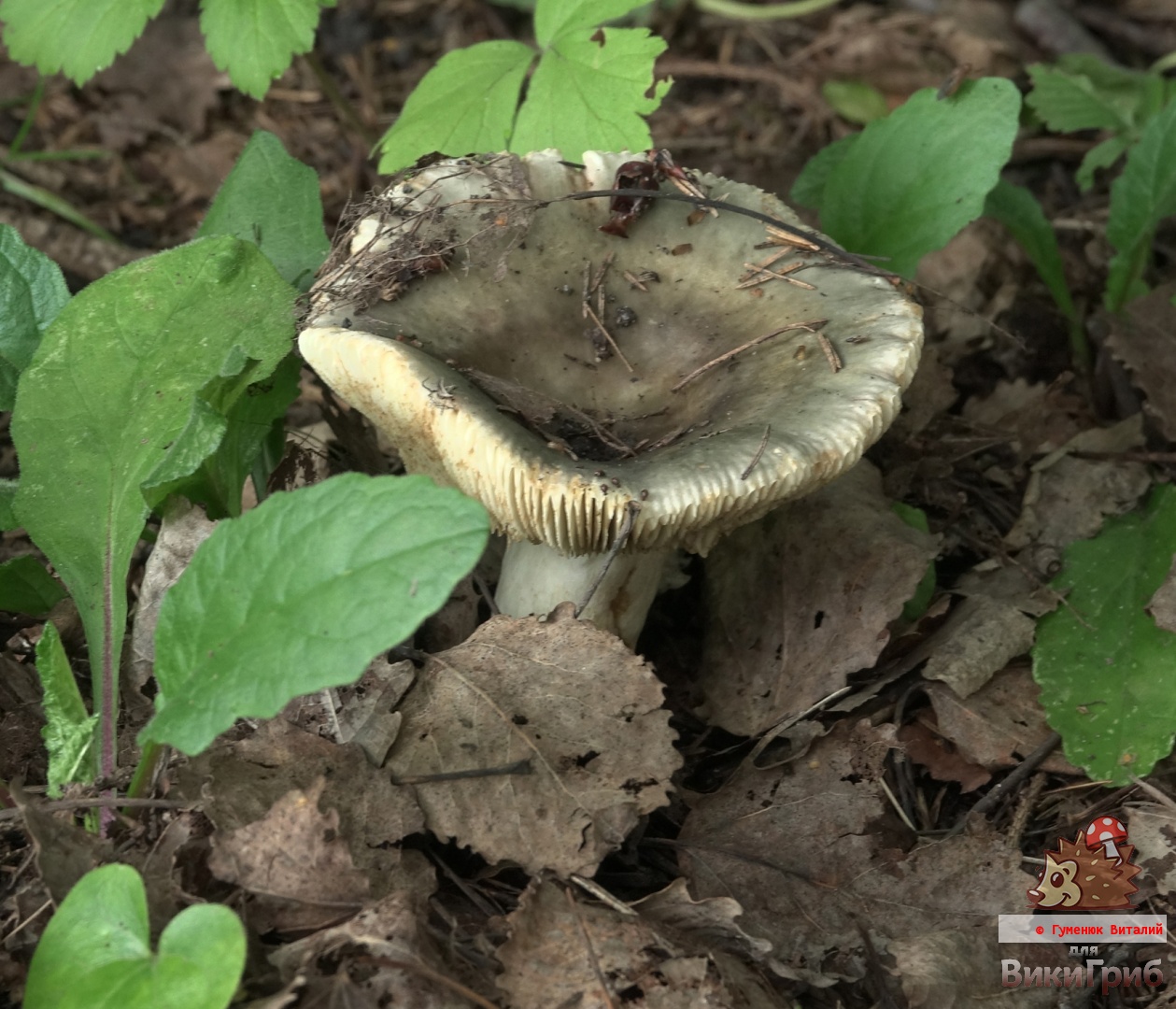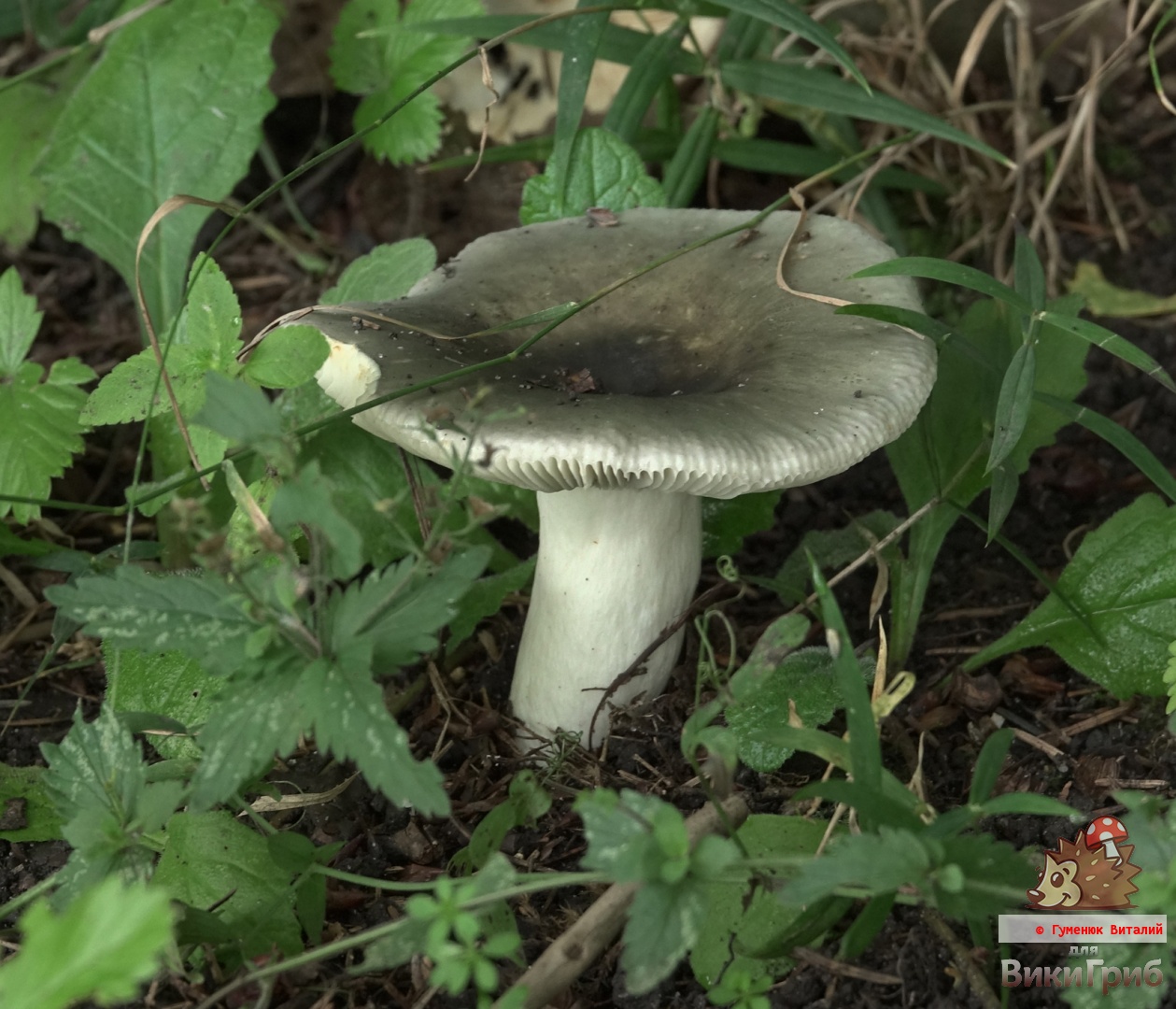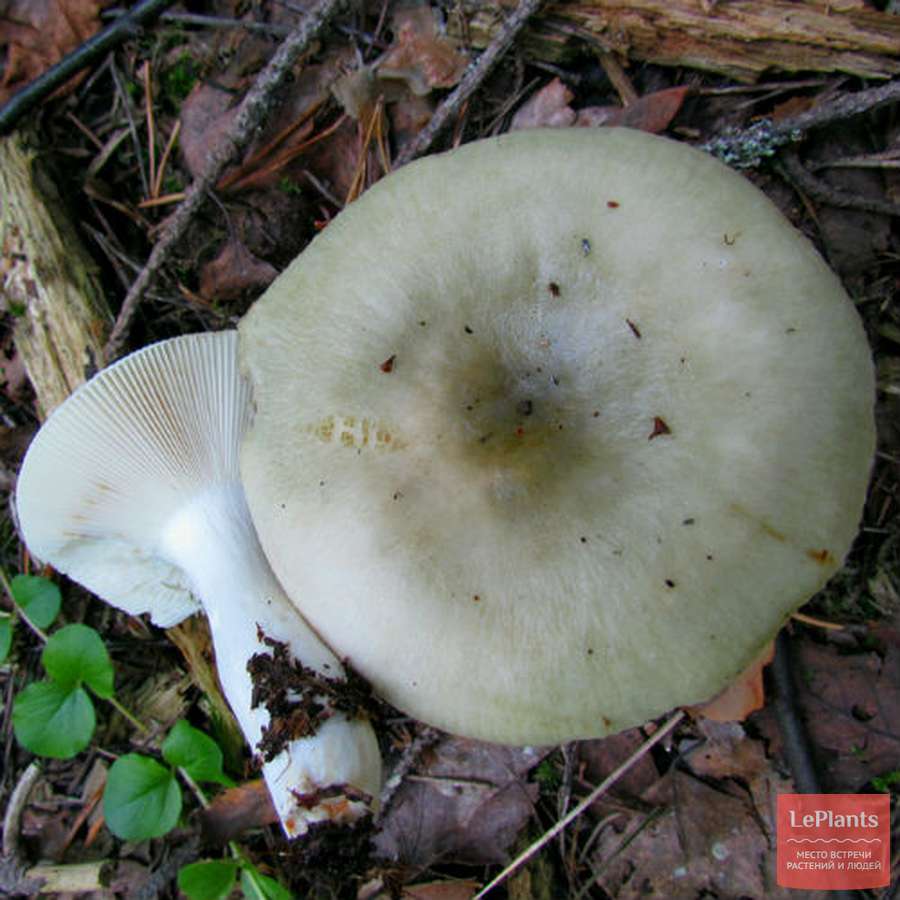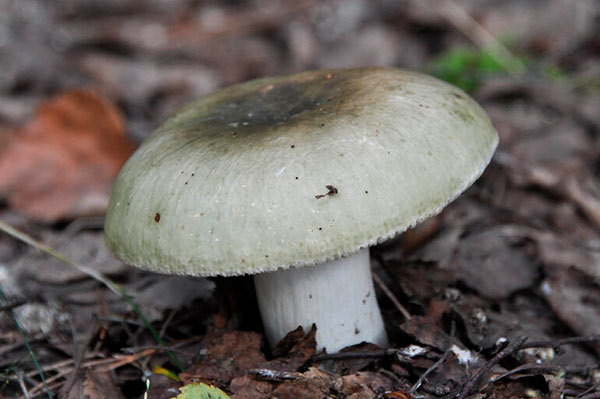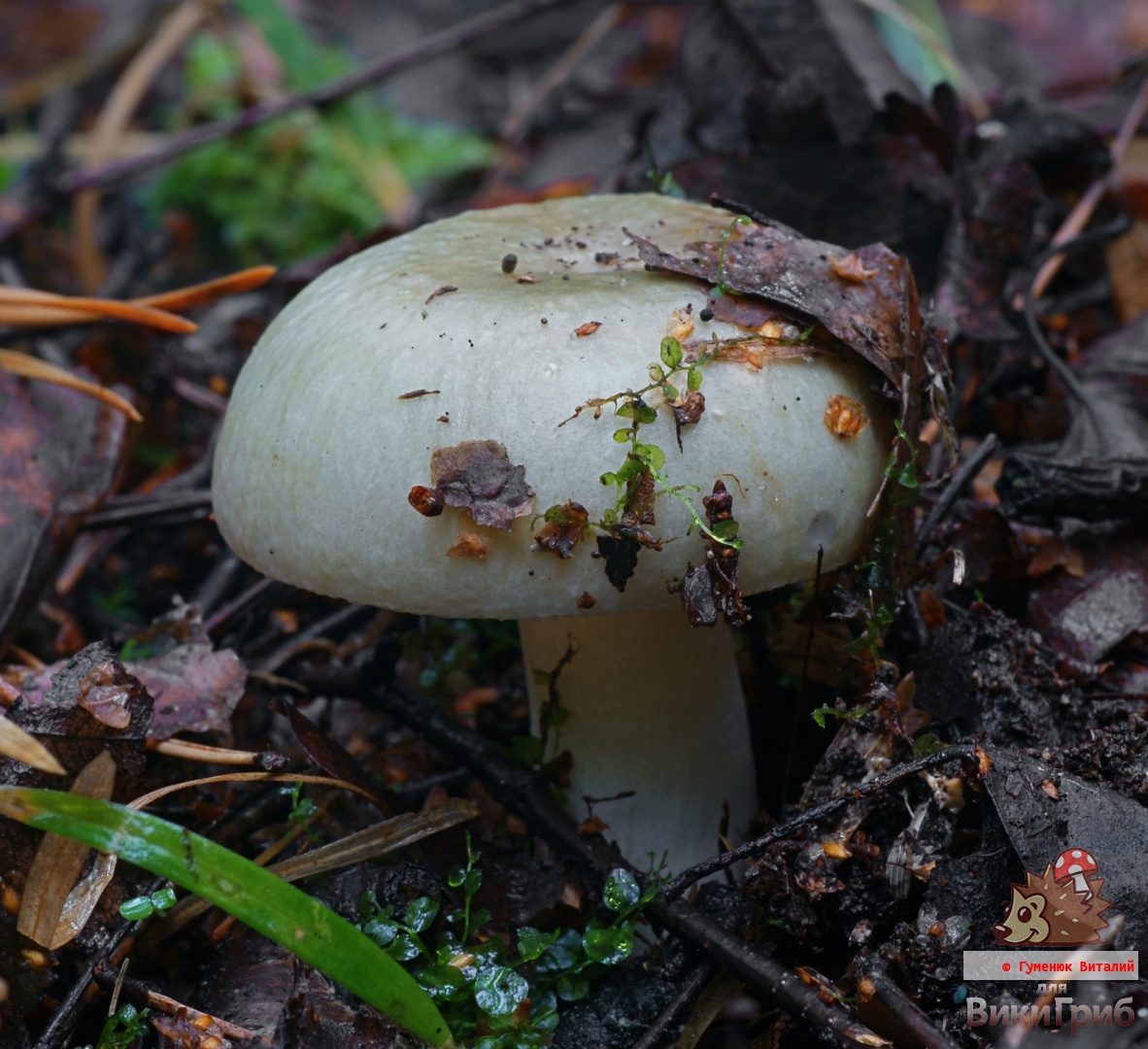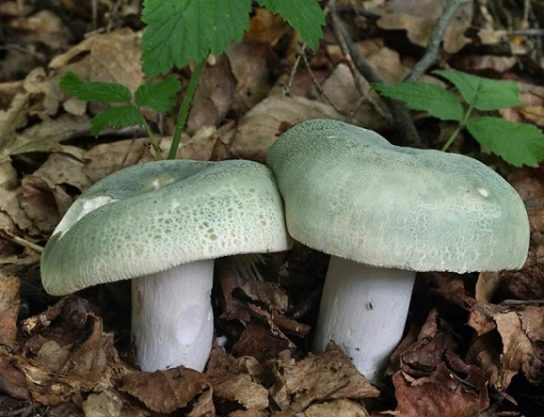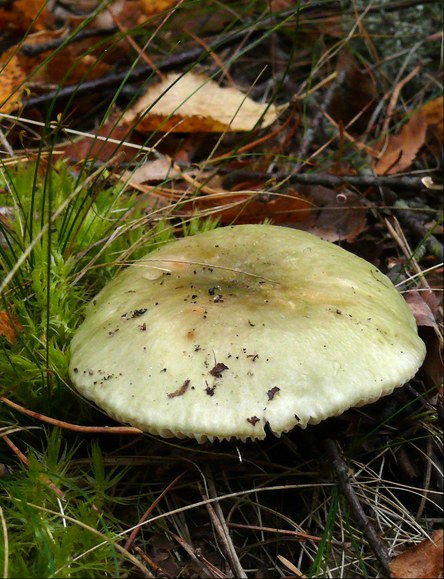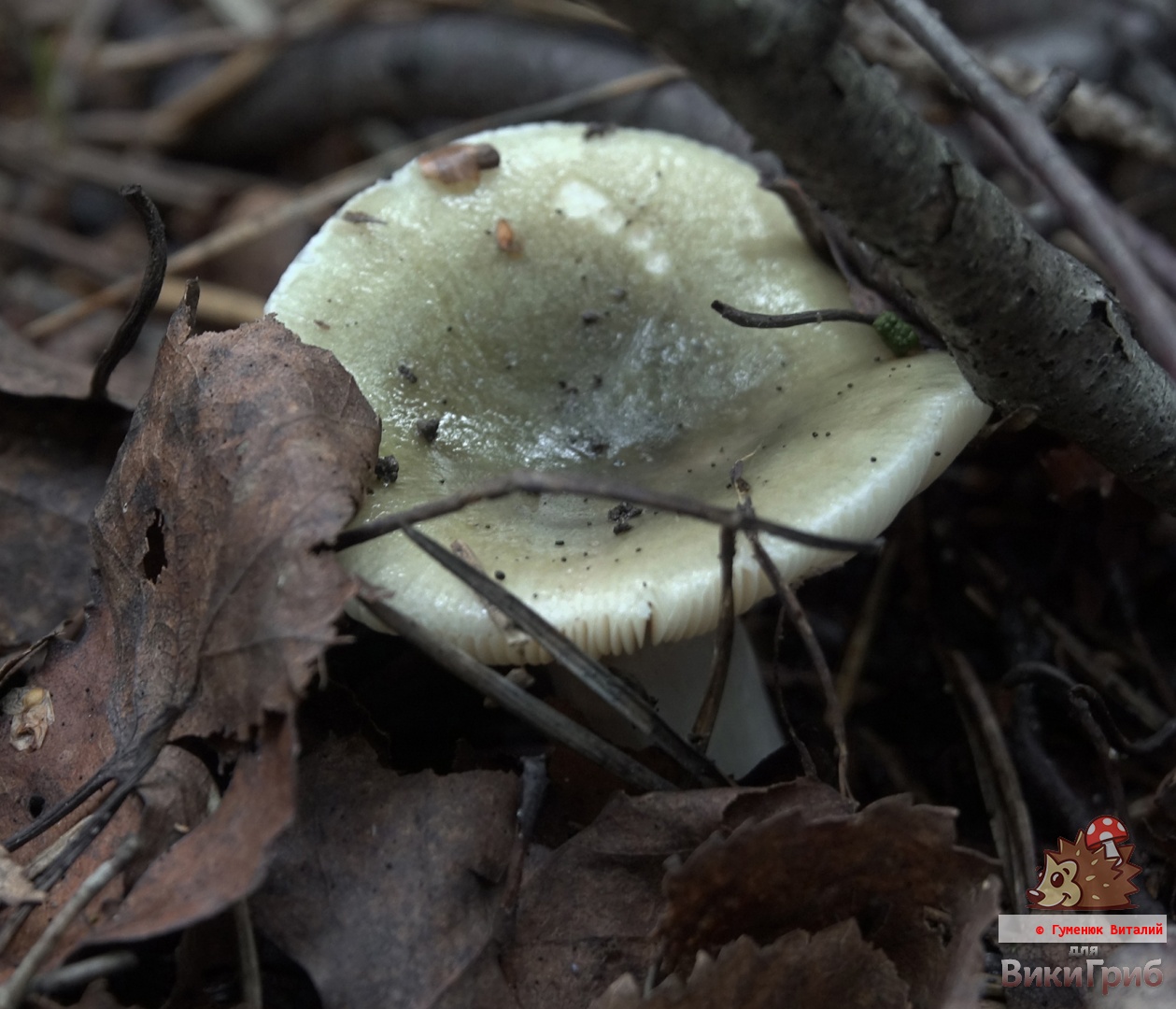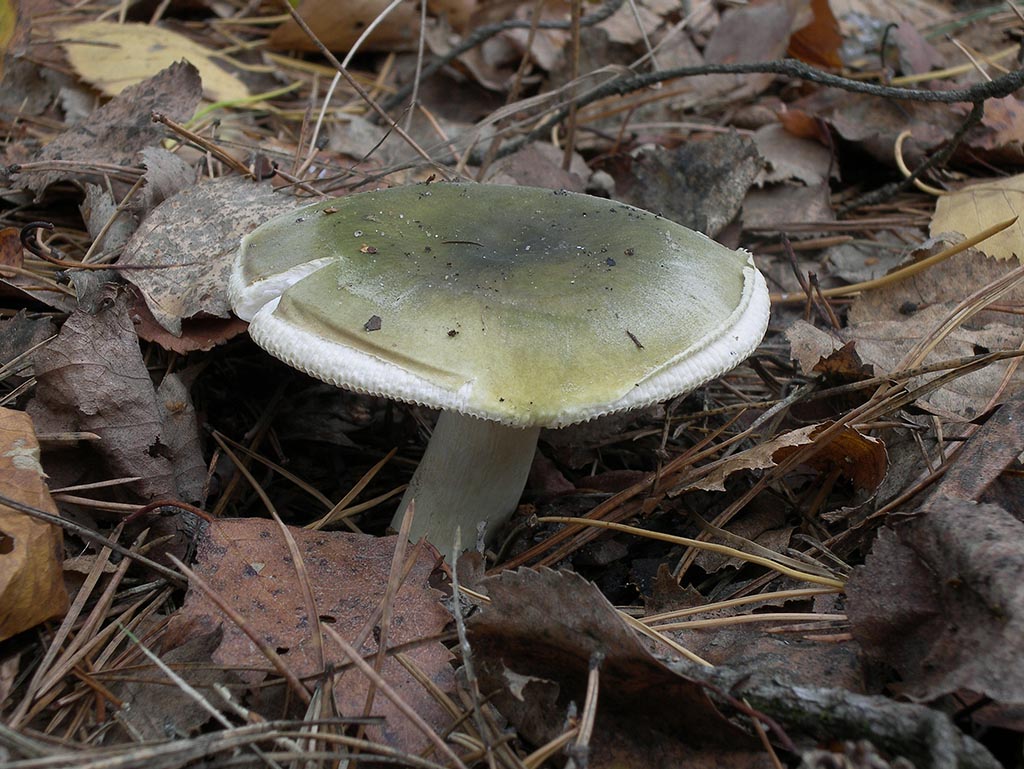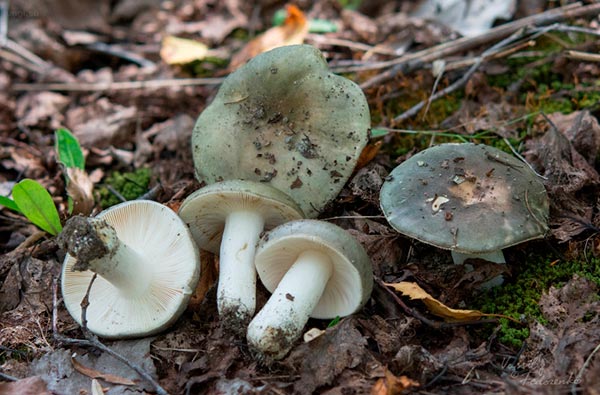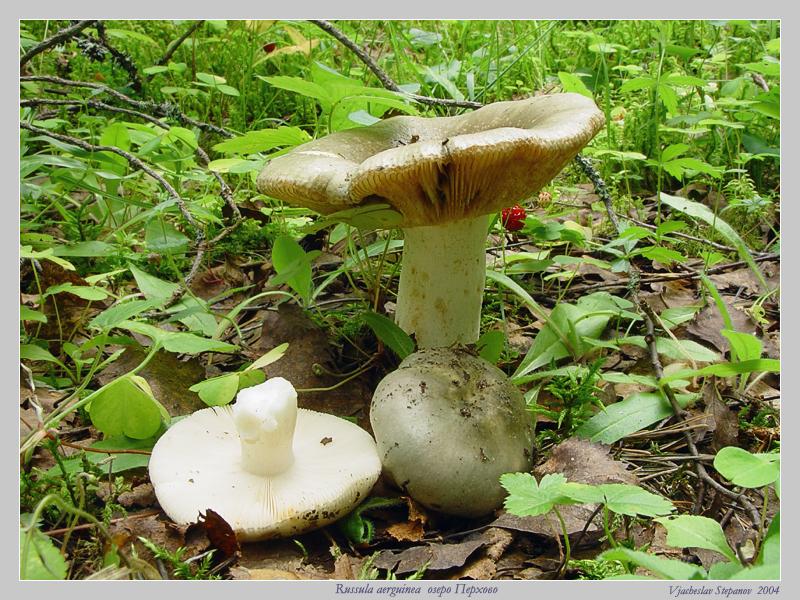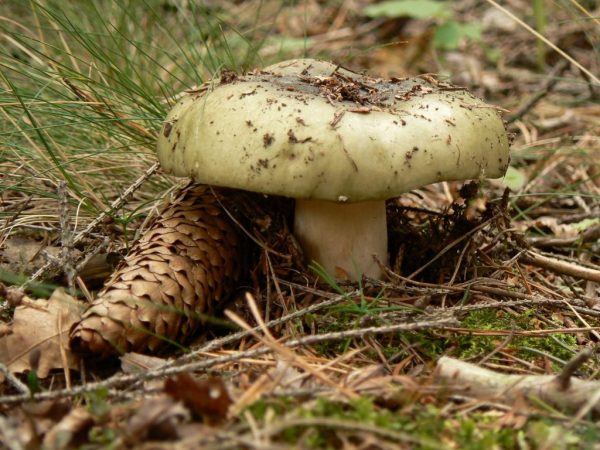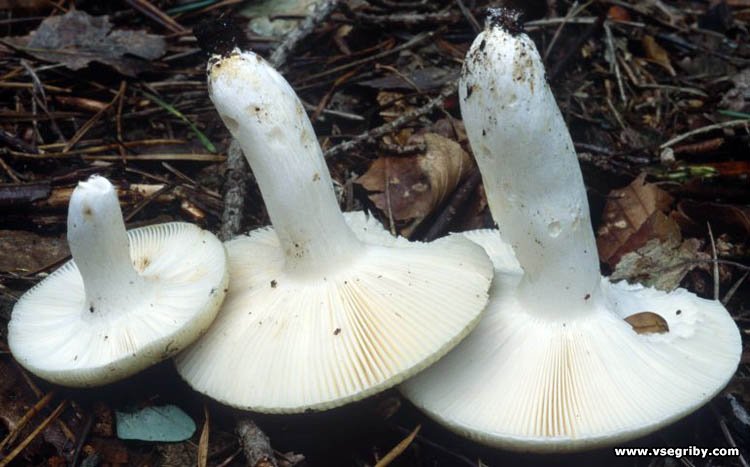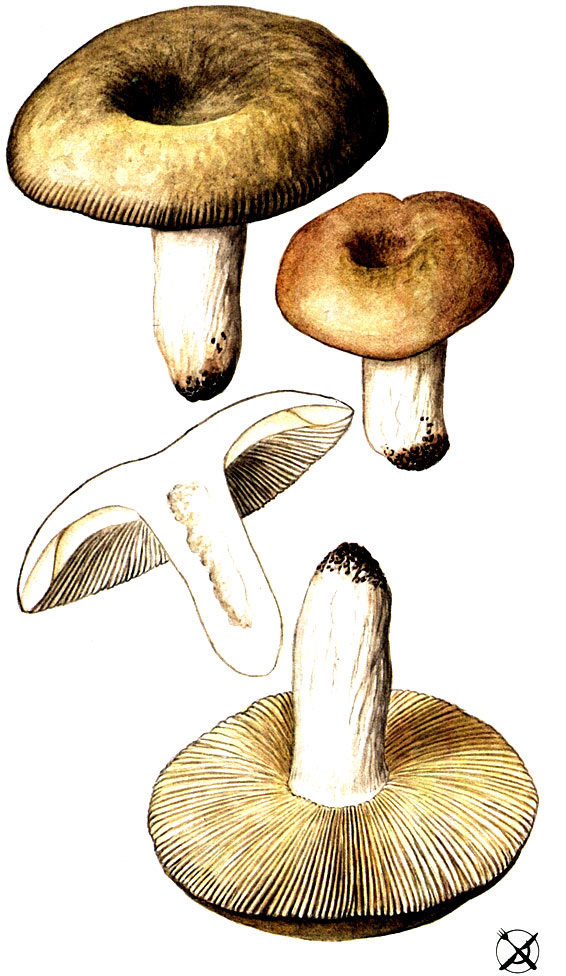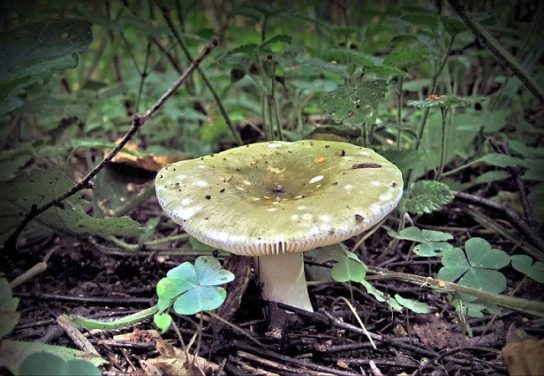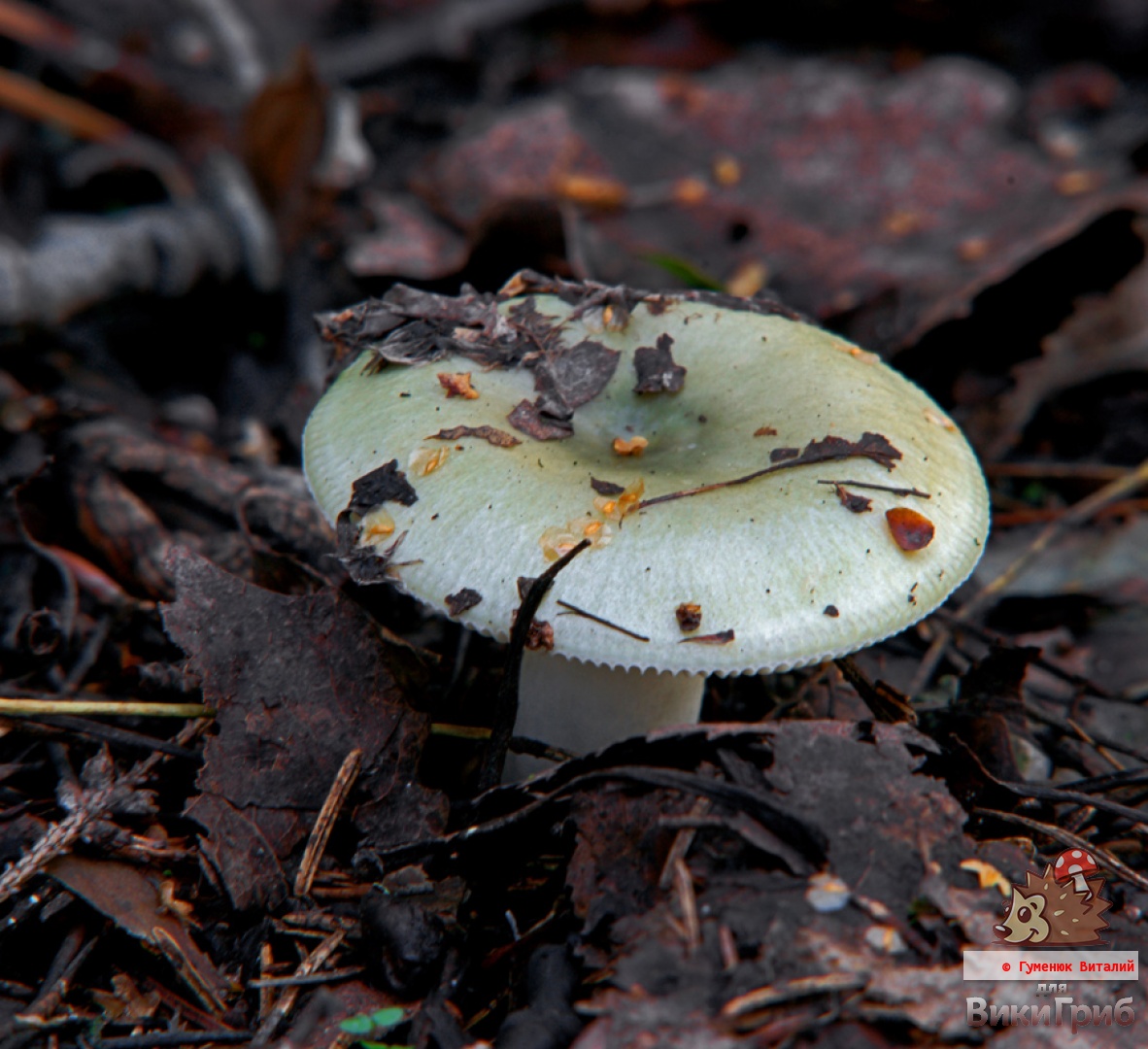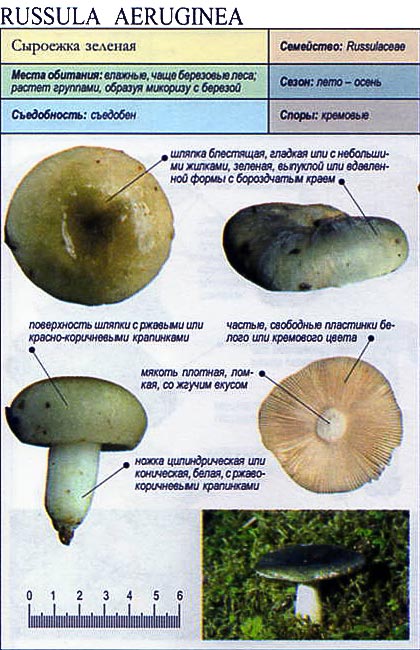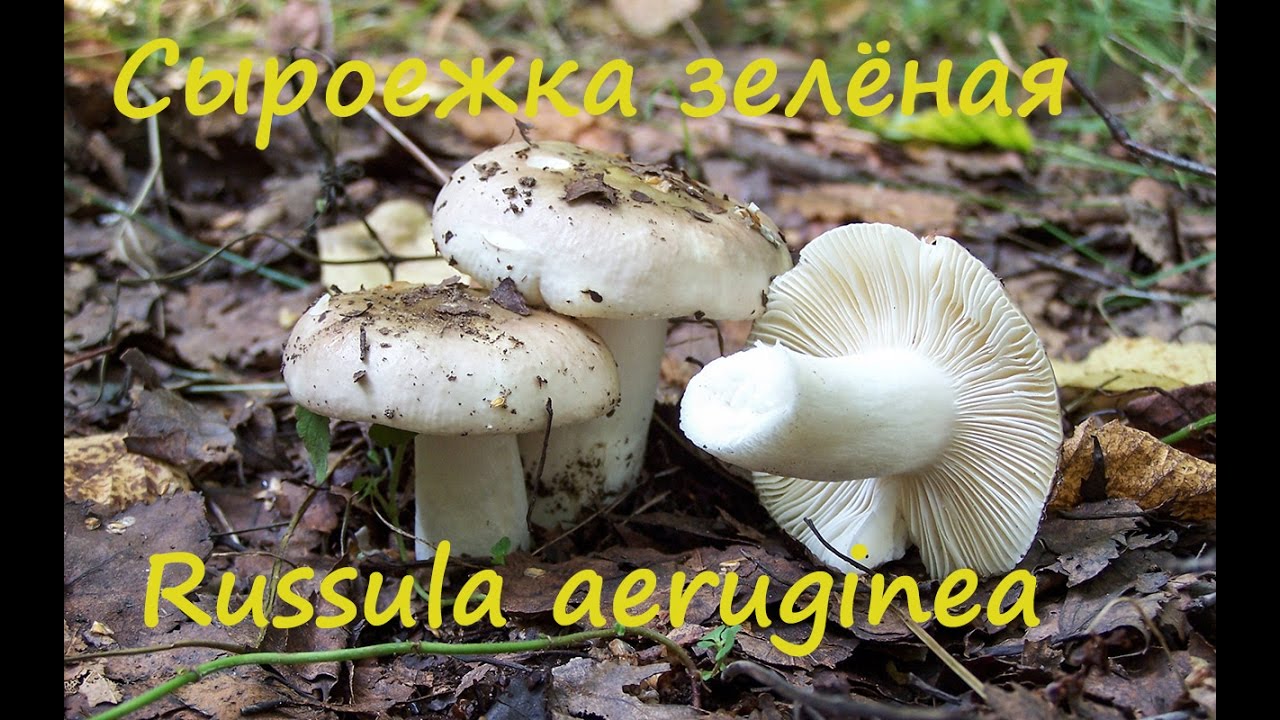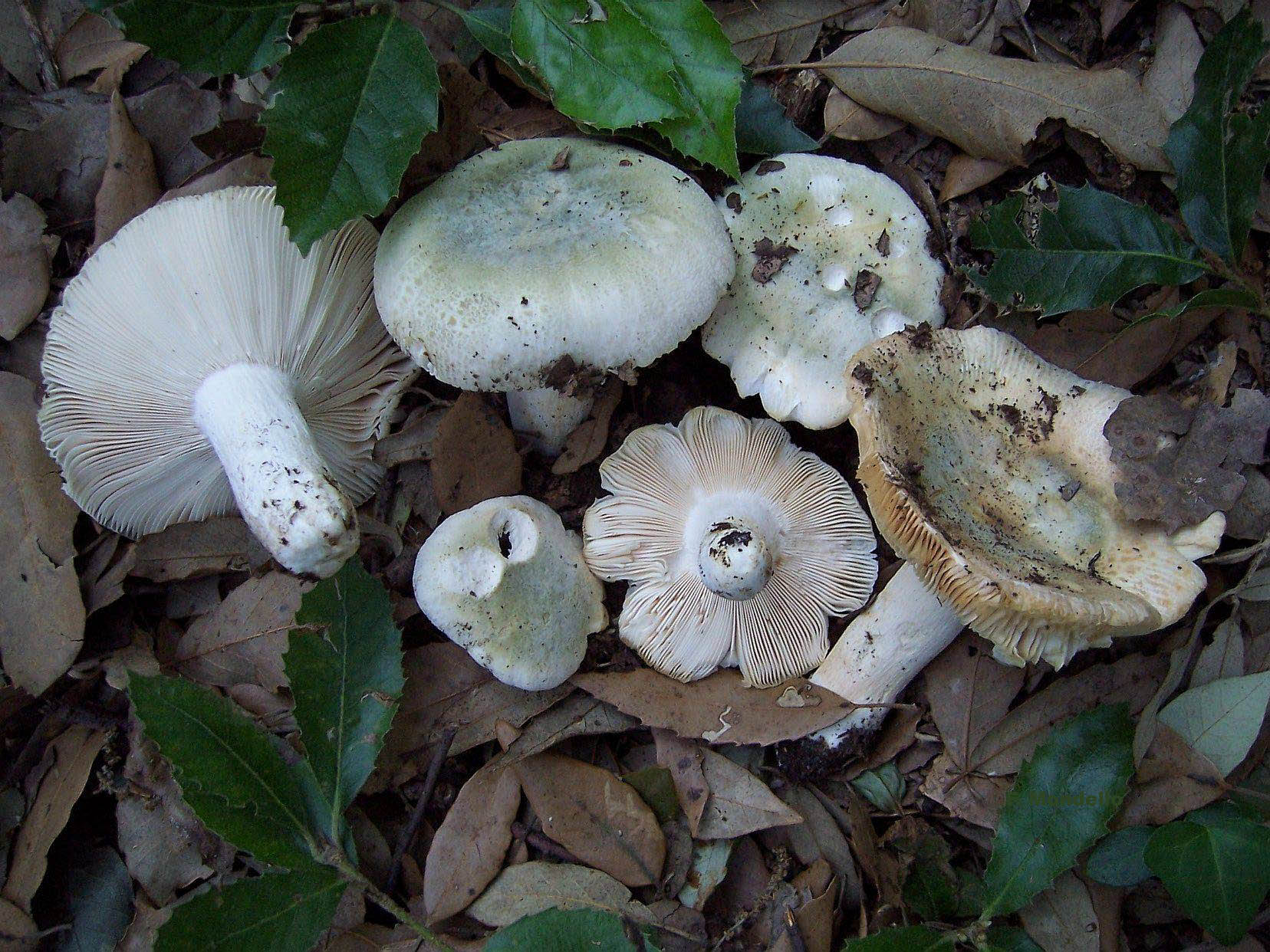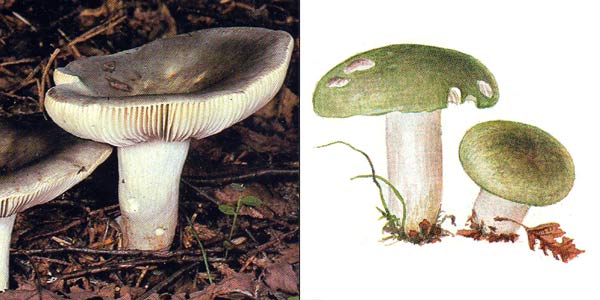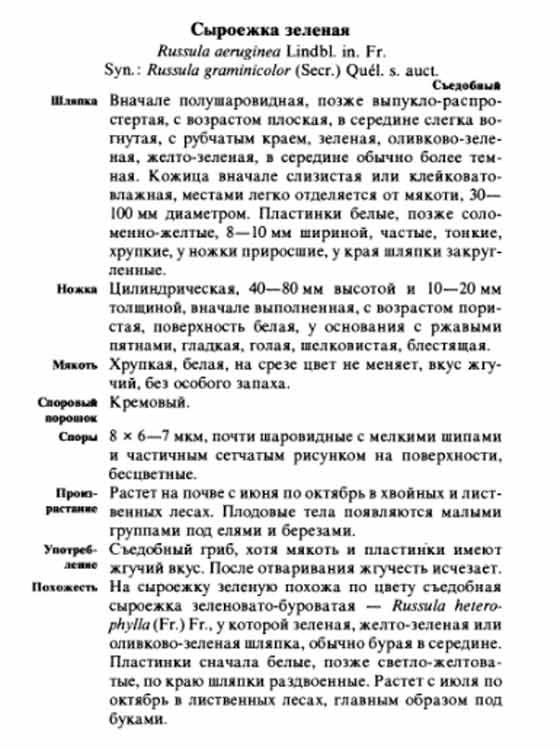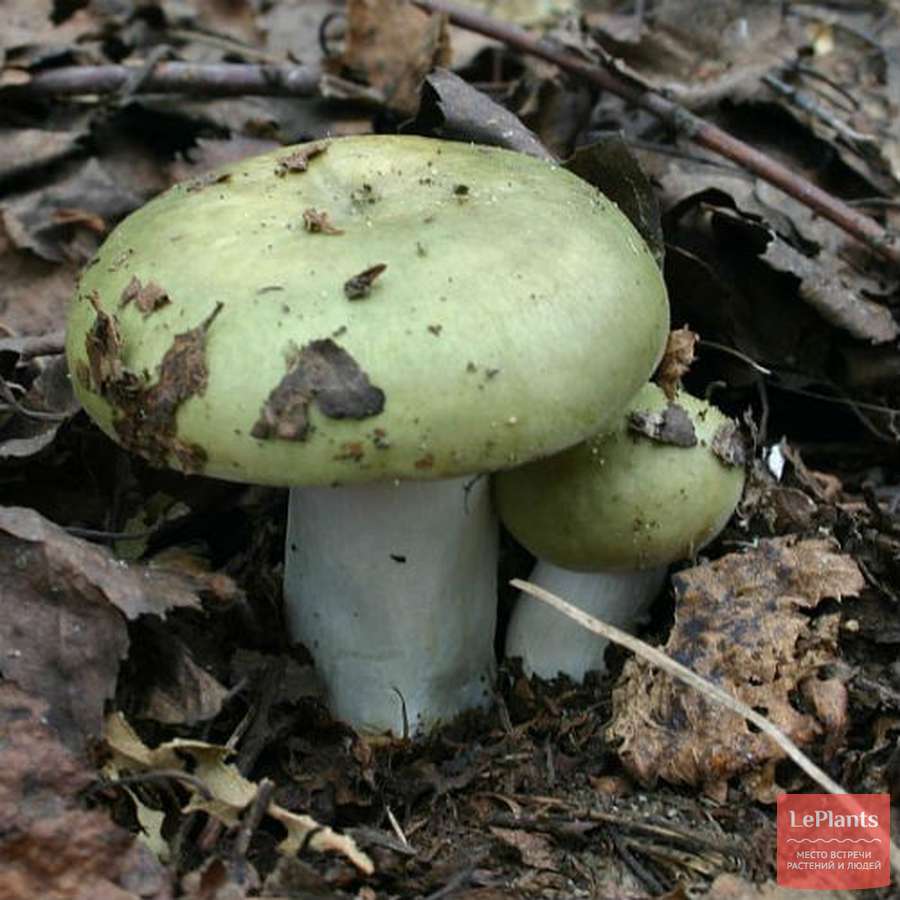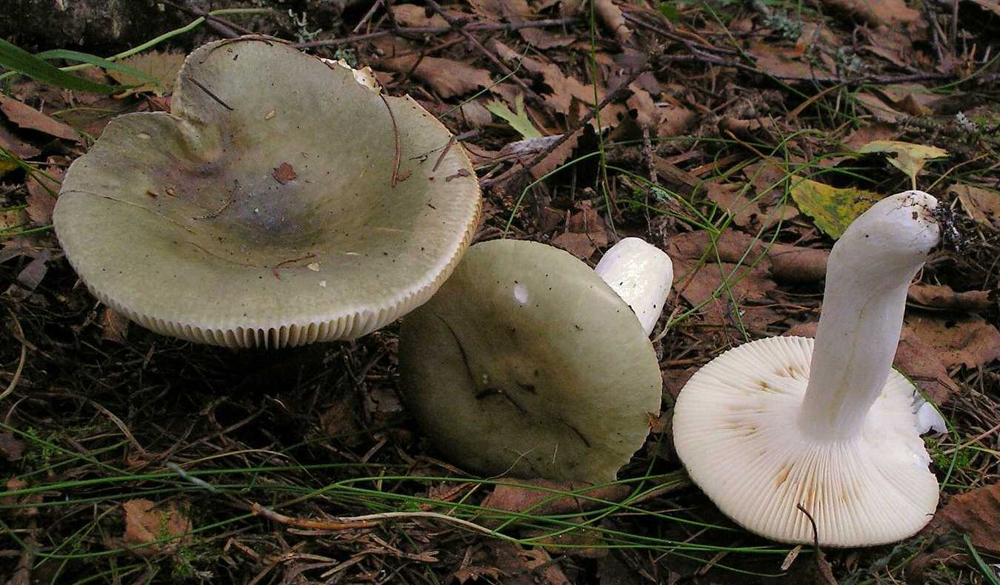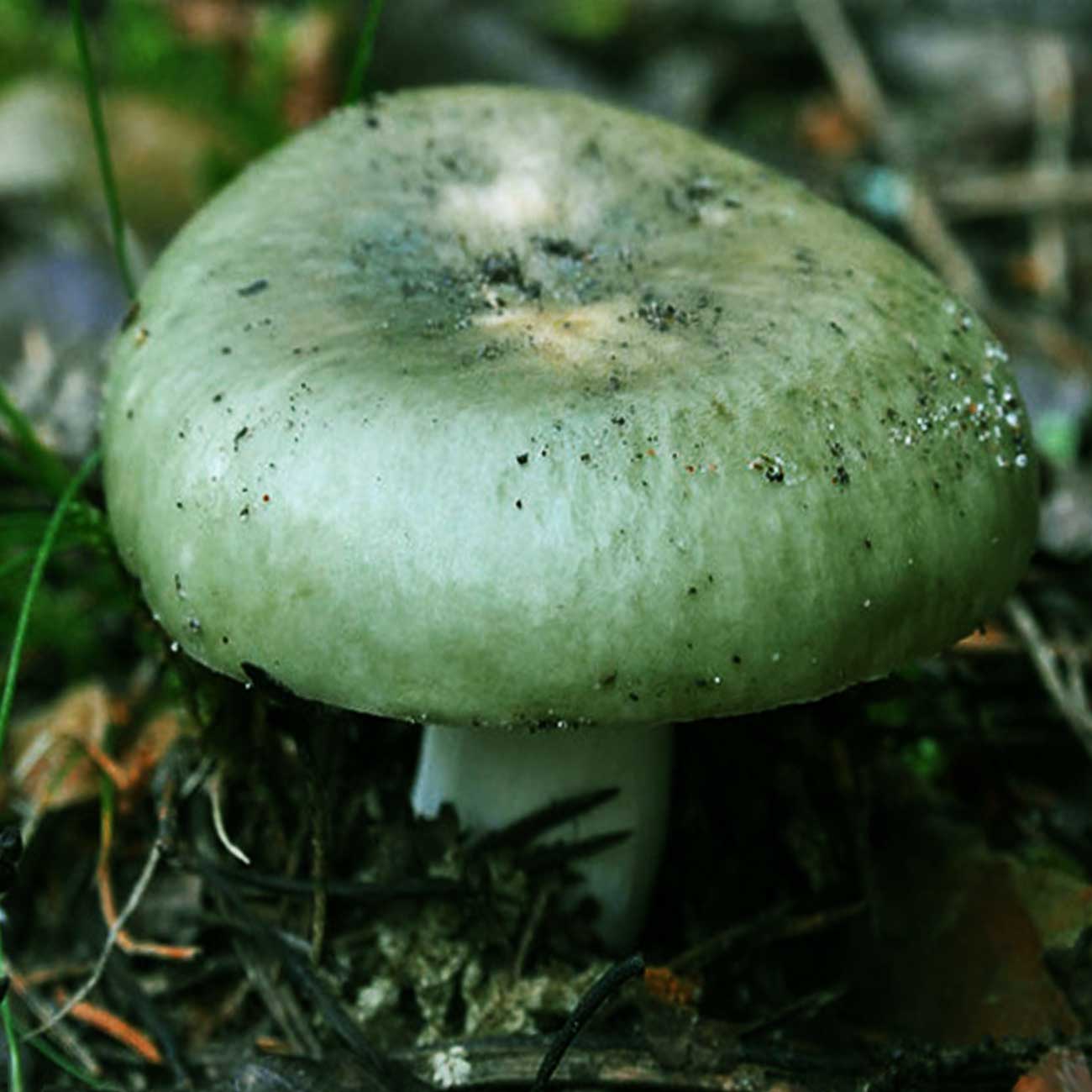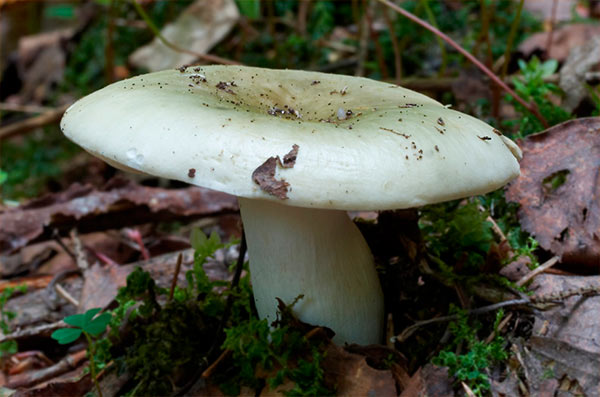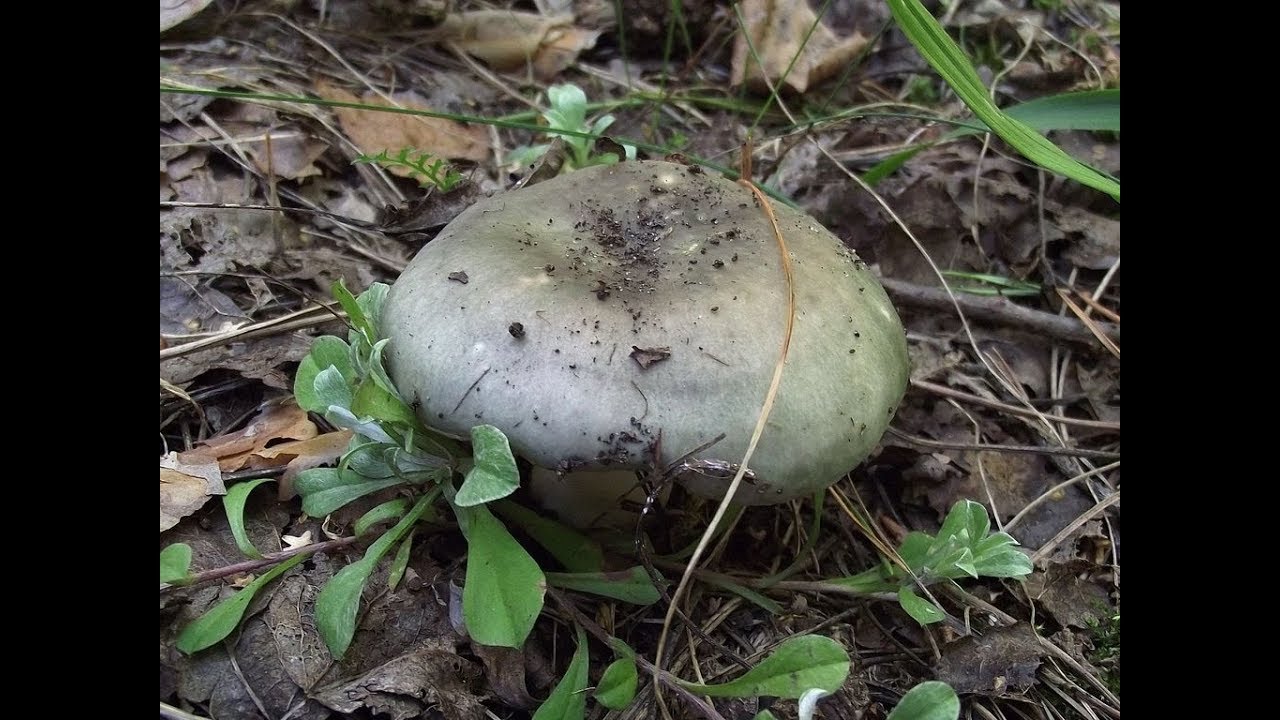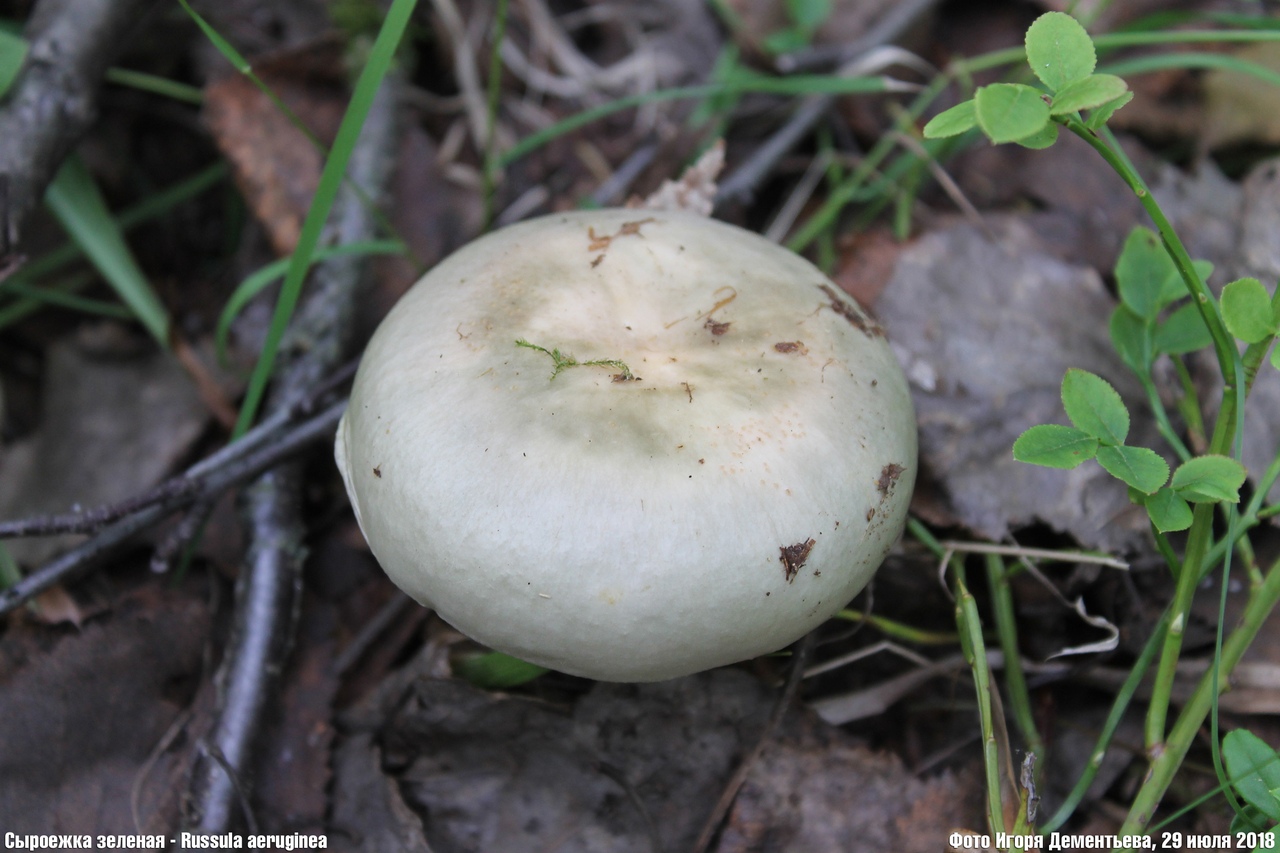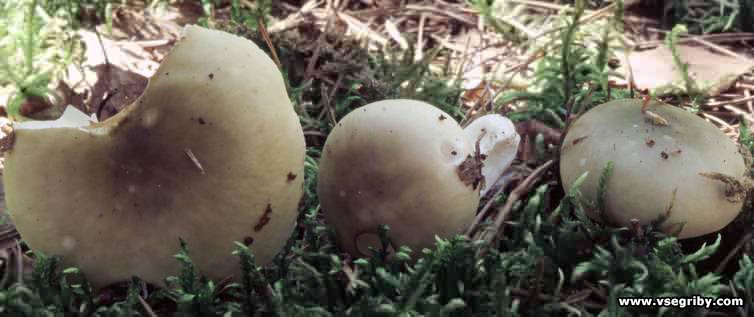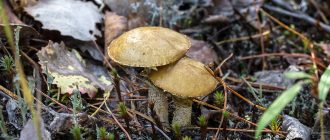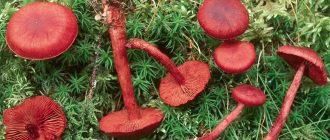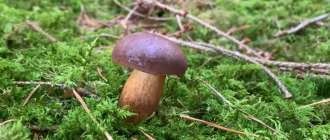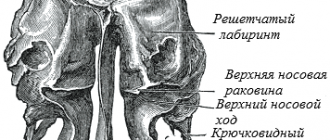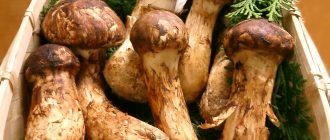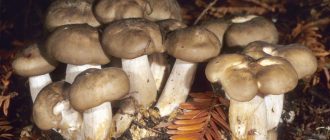Edible russula greenish and its photo
Category: edible.
Cap of a greenish russula (Russula virescens) (diameter 5-16 cm): green, but can be yellowish or bluish. In young mushrooms it is hemisphere-shaped, in older mushrooms it is spread. Fleshy, often cracked. The skin is very thick, it is difficult to separate from the pulp.
Leg (height 4-12 cm): usually white.
If you look closely at the photo of the greenish russula, you can see small scales at the very base of the leg.
Plates: frequent, white or light cream color.
Flesh: firm and whitish, slightly pungent in taste.
Doubles: the greenish representatives of the pale toadstool (Amanita phalloides), differ from the russula in that they have a ring on the leg and a volva.
This edible russula grows from mid-July to early October in temperate countries.
Where can you find it: in deciduous and mixed forests, most often in the vicinity of oaks and birches.
Eating: one of the most delicious russula, which can be eaten after 15 minutes of boiling, pickled, salted or dried.
Application in traditional medicine: not applicable.
Other names: scale russula.
What are edible russula: food
Category: edible.
Hat for food russula (Russula vesca) (diameter 4-12 cm): matte, pink-red, brick or red-brown. In young mushrooms, it is hemispherical, becoming almost flat over time. Slightly sticky to the touch in wet weather. The edges are bent towards the inner side, sometimes wavy and ribbed. The skin does not completely cover the flesh, exposing the plates at the edges, it is easily removed only from the edges.
Leg (height 3-7 cm): white, yellow or pink-rusty, very short, cylindrical. Dense in young mushrooms, hollow in older ones.
The plates of this species of russula mushrooms are very frequent, white or yellowish, sometimes with rusty spots.
Pay attention to the photo of food russula: its pulp is fleshy and dense, white, brittle. No pronounced odor
Doubles: russula relatives, but only the food peel does not cover the plates.
When it grows: from mid-July to late September in Europe.
Where to find it: In all types of forests, especially in the vicinity of birches and oaks.
Eating: delicious mushroom. It is used in any form, provided that it is boiled for 15 minutes.
Application in traditional medicine: not applicable.
Other names: edible russula.
External description of birch russula.
The fruit body of the birch russula is fleshy, it consists of a leg and a cap. The cap is very fleshy and brittle. Its diameter is 2-5 centimeters. In immature fruiting bodies, the edges of the caps are wavy. As they grow older, the cap becomes slightly depressed. Its color can be different - from copper to reddish, but most often it is pink-lilac with a yellowish tinge. In high humidity, the cap becomes spotty and its color becomes creamy. The top skin of the cap can be easily removed.

The flesh of the birch russula is very fragile. The color of the pulp is white. The smell of the pulp is weak, and the taste is pungent. The hymenophore of the birch russula is lamellar. It is formed by thin and sparse plates. The structure of the plate is brittle. They grow together a little with the surface of the leg. The edges of the plates are uneven. The color of the plates is white. Spore white powder. Spores are ovoid.
The legs of birch russula at a young age are very dense, and after rain they become very brittle, as they become soaked. Most often, the thickness of the leg is the same, but sometimes the upper part of it is thinner. The color of the leg is yellowish or whitish. The surface of the leg is wrinkled. Inside, it is hollow, especially in adulthood.

Places of growth of birch russula.
Birch russula are common in Northern Europe. These mushrooms got their name because they grow in birch forests, they are also found in deciduous-coniferous forests, in which there are many birches.
Birch russula prefer wet places; they can be found on sphagnum and in marshy areas. This species is common in Russia, Great Britain, Scandinavia, Belarus. Birch russules begin to bear fruit in July and end in the first half of autumn.

Evaluation of the edibility of birch russula.
Birch russules are classified as conditionally edible, but some mycologists consider them inedible. It is not recommended to eat birch russula raw, as they can cause gastrointestinal upset. Toxic substances are contained only in the upper film, which covers the fruiting body, if the film is removed, then the mushrooms will be safe.

Preliminary preparation
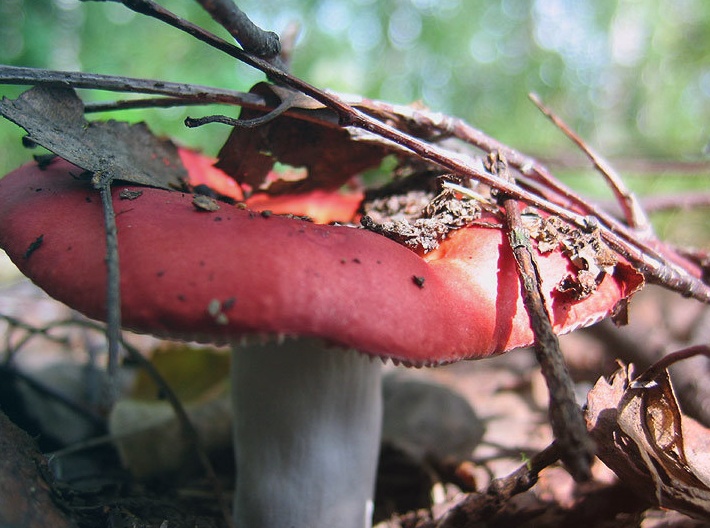
How to salt russula - inexpensive, fast and tasty
The russula have one property - the pulp of these mushrooms, especially some of the species, tends to be bitter, so eating them raw will not work, and before cooking russules for food, they must undergo special training.
The rules for the preliminary preparation of these mushrooms are not at all complicated, but in order for the russula to be properly salted, they cannot be neglected.
It is important to remember that each type of russula has its own taste characteristics - some require more effort in preliminary preparation, others less - everything is decided depending on the specific type. Therefore, before you start cooking mushrooms, you definitely need to have information about the features of the type of russula that you want to cook
Fruit bodies must be carefully examined and sorted out, removing rotten, overripe or overly damaged specimens.
The mushrooms must be peeled and rinsed under running water using a small brush to remove stubborn dirt.
The peel from the cap must be carefully removed - it is she, most often, the source of most of the bitterness. At the same time, be careful, as the cap of the Russula easily crumbles.
For the final elimination of bitterness from the pulp of mushrooms, the fruit bodies must be soaked in water
The period of soaking depends on the type of mushroom, and can be from 6 to 24 hours. At the same time, the water should be changed approximately every 3 hours. After soaking, the fruiting bodies must be rinsed under running water.
Too large specimens are cut into 2 - 3 parts. Small ones can be left as they are. The main thing is that all the individual pieces are the same size - then they will be salted evenly.
You can use enamel and glassware, but they don't like iron russula and can turn black.
It is important, in the future, to follow the rules for storing homemade pickles. Usually they are stored in a refrigerator or cellar, where the temperature regime must be maintained from 0 to +8 degrees.
Also, do not forget about sterilizing the jars in which you will place the russula. Violation of sterilization technology is a very dangerous thing, often leading to very unpleasant consequences. Usually glass jars for pickles are sterilized twice - just before placing the product in them, and immediately after closing the lids.
There are many not at all complicated recipes for salting russula for the winter, and this article presents some of them.
Please note that some recipes use mushrooms that have already undergone special processing, while others this processing is part of the recipe.
Flawless russula taste
The russula flawless is an edible mushroom. According to its taste, it was assigned the 3rd category. These mushrooms can be eaten fresh or salted.
Similar species
Whole russula can be confused with other types of russula, but they have a spicy or peppery taste. This mushroom looks like a green-red russula.
Other mushrooms of this genus
Scaly russula is an edible mushroom. The diameter of its cap is 5-15 centimeters.At first, the shape is hemispherical, but with age, a depression forms in the center, and the edges rise up. The color of the cap is green or gray-green. The edges of the cap are slightly torn, the skin is removed up to half of the cap. The leg is white, dense.
Scaly russula grow in deciduous forests, choosing areas with acidic soil. These mushrooms are harvested from summer to autumn. Outwardly, this mushroom bears a resemblance to the poisonous pale toadstool, so care must be taken when collecting.
Black russula is a conditionally edible mushroom. The diameter of its cap ranges from 5 to 15 centimeters, and the shape changes from convex to funnel-shaped. The color of the cap is dark brown. The surface of the cap is slightly sticky. The leg reaches a height of 3-6 centimeters, while the diameter is quite large - 2-3 centimeters. In structure, the leg is dense, and in color it coincides with the cap. When touched, the leg turns black.
Black russula grow under the pines. They prefer acidic soils. Fruiting from July to October, but not too plentiful. They grow mainly in the northern regions. In terms of taste, they belong to the 4th category, they are suitable exclusively for salting. The taste of salty russula is sweet and pleasant.
Similar species
Green russula is included in a complex of species that differ only in microscopic structure.
- Russula anatina Romagn., 1967 grows under oak, beech and hornbeam.
- Russula atroglauca Einhell., 1980 also grows under a birch, with a darker cap. The most significant differences are in the structure of the cap cuticle.
- Russula cyanoxantha (Schaeff.) Fr., 1863 with sometimes a green cap is distinguished by unbreakable plates.
- Russula medullata Romagn., 1997 occurs mainly under poplars, it is distinguished by bright yellow plates with age and ocher spore powder.
- Russula ochrospora (Nicolaj) Quadr., 1985 grows under a linden tree, differs in ocher spore powder.
- Russula parazurea Jul. Schäff., 1931 is also found under birch, it is distinguished by a bluish cap with a bluish tint and lighter plates.
- Russula pseudoaeruginea (Romagn.) Kuyper & Vuure, 1985 grows under oak and beech. Differs in the microscopic structure of the cuticle.
- Russula stenotricha Romagn., 1967 grows under various deciduous trees. Differs in the structure of the cap skin.
- Russula subterfurcata Romagn., 1967, with strongly branching blades at the stem, grows under oak and beech. It also differs in the structure of the cap skin.
Russula fading
| Group: | Lamellar |
|---|---|
| Plates: | White |
| Colour: | Crimson |
| Info: | On the cut turns red |
| Department: | Basidiomycota (Basidiomycetes) |
|---|---|
| Subdivision: | Agaricomycotina (Agaricomycetes) |
| Class: | Agaricomycetes (Agaricomycetes) |
| Subclass: | Incertae sedis (indefinite) |
| Order: | Russulales |
| Family: | Russulaceae (russula) |
| Genus: | Russula (Russula) |
| View: | Russula exalbicans (Russula fading) |
Description
The beautiful russula is characterized by a bright color of the cap, which "fades" over time, hence the name of the species.
Hat
Fading russula caps are usually small (up to 10 cm in diameter), but there are extremely large overripe specimens. The color is usually close to crimson, with darker edges. Enlightenment can be observed in the center. Small russules have spherical, gradually opening caps. The surface of the cap is dry and smooth. With the maturation of the mushroom and an increase in its size, the color of the cap turns pale. The skin is difficult to separate from the cap.
Leg
The leg of a beautiful russula is relatively thick and low (about 3 cm in thickness and 6 cm in length). It is cylindrical in shape with a downward extension. Its color is predominantly white with a pinkish tinge in the upper third. In the lower third, yellow spots may appear.
Pulp
In young specimens, the flesh is white, and in old specimens it is grayish, it turns red on the cut, then turns gray. The consistency is dense, tough, especially at the legs, so many people prefer to eat only hats. The raw mushroom tastes bitter, but when cooked it is sweetish.
Distribution and collection
The beautiful russula is widespread almost all over the world, but prefers temperate latitudes. Symbiotic coexistence is usually found in russules fading with deciduous trees. But the growth of this species is also possible in coniferous forests.
Similar species
The fading russula has a rather characteristic appearance so as not to be confused with other mushrooms. The only mushroom that looks a little like her is the russula, burning or emetic.
The latter is distinguished by whiter plates (not darkening in mature mushrooms) and pulp that does not gray out on the cut. This mushroom has a very bitter taste, therefore it is considered inedible.
Its use can cause stomach troubles, which reflects its name. However, according to some sources, russula emetic becomes edible when boiled well.
Edibility
The beautiful russula has, according to many consumers, very mediocre taste. The legs of these mushrooms are rarely eaten because of their rigidity. We can say that russula is an amateur mushroom, suitable for those who prefer a strong food consistency. After boiling, russula are fried with potatoes, salted and pickled.
Interesting facts
Russula mushrooms, including such as the fading russula, are characterized by a number of interesting properties:
- Russulin contained in russula promotes milk curdling, therefore russula components can be used in cheese making.
- Lecithin, which is part of this mushroom, lowers the level of bad cholesterol in the blood.
- Regular use of russula cleanses the gastrointestinal tract.
- The russula got its name not because it can be eaten raw. Quite the opposite: like any conditionally edible mushroom, it requires preliminary digestion.
And the name comes from the fact that pickles from these mushrooms are prepared faster than from the rest.
Not all mushroom pickers collect russules. Many people neglect them, because there are boletus, moss and other, more "valuable" mushrooms. However, fried or salted russula are also quite edible and tasty.
Russula: description and photos of mushrooms. What does a russula look like?
Hat
The fruit body of russula consists of a cap and a leg. The shape of the cap changes as it grows and develops. In young russula, it is semicircular, almost spherical, hemispherical; then it becomes convex or convex-outstretched, and in old mushrooms - flat with a concave center or funnel-shaped.
The edges of the cap in different types of russula can be ribbed, wavy-curved, tuberous or smooth, changing with age. In some species, the edges are straight, in others they are lowered or raised. The sizes of the caps vary from 2 to 15 cm.
Whole russula
The skin covering the cap, even in mushrooms of the same species, can have:
- either smooth, damp and sticky;
- or dry, matte, soft velvety.
The adhesive surface can dry out over time, and sometimes it is dry initially.
The peel from the pulp of the cap lags behind in different ways:
- easy (in birch russula (lat.Russula betularum);
- up to half (in the solar russula (lat.Russula solaris);
- only along the edge (at the golden russula (lat.Russula aurea).
The color of the russula cap includes almost all shades of the solar spectrum: red, yellow, green, purple, bluish, brown. The color is not always monochromatic: sometimes it has uneven spots and various color transitions, as if fading in the sun.
Hymenophore
The russula hymenophore, or the lower surface of the cap, consists of widely or narrowly adhered plates of various lengths, thicknesses, frequencies and colors. Russula plates can be white, light yellow, light cream, slightly pinkish, ocher, lemon yellow.
Leg
More often there are russules with cylindrical, regular-shaped legs, less often - with fusiform (olive russula (lat.R. olivacea), clavate (golden russula (lat.R. aurea), cylindrical, but narrowed towards the base (food russula, or edible (lat. R. vesca). The leg is attached to the middle of the cap. Its flesh changes with age, in young mushrooms it can be full, that is, loose, cotton-like or dense. With aging, cavities appear in it, it becomes spongy and fragile.The color of the leg can be either light: white, yellowish, cream, pinkish, and dark: gray or brown. At its base, rusty spots may be present, as, for example, in the green russula (Latin R. aeruginea). The surface of the leg is smooth, naked, silky or velvety, and may become slightly wrinkled with age.
Light yellow russula
Pulp
The flesh of the cap is mostly white or very light in color; thick or thin; odorless or with a faint aroma and a different taste. When the fruiting body of the russula breaks, the milky juice is not released.
The plates, pulp and legs of russula are very fragile. Fragility and fragility of these mushrooms is given by spherocysts - special groups of vesicular cells that are found in the fruiting body.
Swamp russula
Spore powder
The russula spore powder also has a different color: whitish, cream, light cream, yellow, light ocher.
First aid for poisoning with mayr's russula
The main actions in case of poisoning with mushrooms of the Mayra species should be aimed at removing toxic substances using gastric lavage and enemas.
You should proceed as follows:
- Drink in small sips about 1 liter of warm water diluted with potassium permanganate until pink.
- Touch the root of the tongue with your fingers, causing vomiting.
- Continue drinking water and induce vomiting until the vomit is clear and free of food or bile.
- Take activated charcoal and lie down to regain strength.
You need to continue to drink a little water to avoid dehydration. A decoction of herbs such as chamomile, peppermint and juniper berries are suitable.
Description of wavy russula
It is a plastic mushroom. The cap in young specimens is bell-shaped or hemispherical; in the process of growth, the convex shape changes to an outstretched one, and reaches up to a depressed one, while the edges are bent. The diameter of the cap in mature specimens is 13-15 centimeters.
The characteristic color of the cap of young mushrooms is gray-green, later the shade becomes olive or purple with a black-purple or dark brown center. The cap is dense, smooth, fleshy. In young fruiting bodies, the surface of the cap is shiny, sticky, and in adults it becomes dull. The edges of the cap can be wavy or even. The skin can be removed by a third from the cap.
The plates are located often, their color is initially white, but over time they gradually turn yellow. Most often, the plates are wide, they can be either descending or free. The length of the plates is the same and different. The texture of the plate is brittle with pointed edges.

The leg of the russula is wavy, cylindrical, flat. Its height ranges from 4 to 10 cm, and its thickness is 1-3 cm. The color of the leg is white with a pinkish tinge in the upper part and yellow-brown at the base. In mature specimens, the legs turn gray and even brown.
The flesh of the black-purple russula is dense, especially in the leg. The color of the pulp is white, but when broken or cut, it has a characteristic pink tint, then it turns red, and then turns gray and may even turn black. The taste and smell of the pulp of young mushrooms is pungent, but the mature fruiting bodies have a sweetish taste and a pleasant fruity aroma. The wavy russula does not have milky juice. Spores are spiny, yellow-white in color, almost spherical in shape.
Growing places of black-purple russula
These mushrooms are found in coniferous and deciduous forests, among pines, oaks, beeches. They bear fruit from mid-August to October. They grow singly or in groups. They prefer mountainous or hilly terrain. They are found most often in humus under trees.

Edible russula wavy
Russula wavy is an edible mushroom of the 3rd category. It has a strong flesh, so it does not break when picked. Black and purple russula are suitable for preparing various hot and cold dishes, as well as for salting.
Dangerous resemblance
The edible wavy russula has a poisonous "twin" - the burning russula. These mushrooms are very similar in appearance, but the latter is very toxic. It is not for nothing that the stinging russula is called vomiting and nauseous, it causes gastrointestinal upset. There is evidence that these russules contain muscarine. Some mushroom pickers, nevertheless, use burning russula for food, for this they pre-boil them for 20 minutes and wash them.
The cap of the stinging russula is at first convex, and over time it becomes more and more open, and as a result, completely depressed. The edges of older specimens are ribbed. Coloring from bright red to pinkish with ocher and white spots. The leg is cylindrical, hollow, strong.

Scorching russula quite often grow on peat bogs in various places. Also found in deciduous forests, less often grow in coniferous forests. These mushrooms love mountainous terrain. They bear fruit from July to October.
Description
The cap reaches 4-14 cm in diameter, first convex, then flattened and depressed. The color is grass-green, sometimes yellowish-brownish, but not grayish and not lilac. The skin is shiny, slimy, removable for about one third of the cap.
at first they are rather frequent, fragile, then diverging, almost free from the stem, occasionally branching next to it.
The leg is cylindrical, white, with age, covered with brownish spots.
The pulp is strong, white, then yellowish. The taste is sweetish, pungent at the plates, the smell is subtle.
Spore powder of cream color. Spores 6-10 × 5-7 µm, elliptical, warty, with a very incomplete mesh. The hyphae of the cap cuticle are not swollen, filiform, with rectangular cells.
Edible, has a pleasant, non-bitter taste.
Edible
The rest of the mild-tasting russula can indeed be eaten raw, but do not do this due to the possible confusion in the re-grading of mushrooms.
Let's list the edible russula with a brief description:
- Marsh - red or dark orange in color with a dense cap, grows in damp coniferous stands in glades. Taste for 5.
- Stormy - a weak herring aroma will confuse a novice mushroom picker, but these brown maroon mushrooms are a delicacy because of their rich taste.
- Yellow - from a distance it looks like a chanterelle, but in the shape of the cap and legs, it is a typical russula. Mushroom of the third category with no pronounced taste.
- Green-red - the color of the cap changes in this color scheme, and on one mushroom. The taste is C grade.
- Golden - yellow-red caps of this mushroom will tell you that it is a welcome guest in salting and frying.
- Brittle - pink-purple color and fragility of the pulp characterize this russula. Moreover, it has no taste, it can only be used in pickles.
- Cherry laurel, or almond - resembles Valui in light brown color, differs in a leg without a hole and a straightened cap.
- Morse is also light brown, but this species has such a color at the leg and plate. Average taste, good mushroom in pickles with preliminary soaking.
- Gray - so named due to the fact that cuts or breaks turn gray in the air. The mushroom itself is yellow-brown on a leg high for russula, up to 10 centimeters.
- Blue-yellow - blue-lilac in color with areas of yellow tint. Differs in the finest nutty taste.
- Azure, or blue - a blue-violet mushroom in color similar to a purple ryadovka. Taste puts azure on the 2-5th place among russula.
- Turkish - fragrant and tasty russula of brown or purple flowers, grows in conifers.
- Wonderful, or impeccable - olive green turning into reddish purple. Edible mushroom of the third category.
- Greenish - considered the most delicious russula, with a green or gray-green cap.
Inedible
Immediately, we note the inedible species of russula, of which there are not so many.These mushrooms are not poisonous, but the bitterness they contain gives the right to classify them as conditionally edible. The pungent taste is removed by some types of pre-processing: soaking or boiling, but eating raw is out of the question.
- The russula is pungently caustic - a mushroom of light pink or bright red color. The difference from other types is an easily removable film on the cap, the removal of which reduces the bitter taste.
- The russula is fading, less saturated with pink-red tones than the previous mushroom, but also has a persistent bitterness.
- The blood-red is distinguished by the aforementioned color of the cap, and the leg of this species is also painted in bright pink.
- Mayr's russula - looks like red, only with bitterness, one more difference - it crumbles strongly.
- Sharp russula - purple or lilac mushroom with burning pulp.
- Birch russula - light pink with an easily removable film, as the name suggests, grows in birch plantings.
A uniting quality in inedible russula, they are also incorrectly called false, bright, as if screaming about danger. But as mentioned above, after appropriate processing, the mushrooms are edible.
How to collect and prepare russula?
Collecting russula should be carried out only in baskets or enameled buckets. The plates of mushrooms are brittle, crumble quickly, so you cannot carry them in bags, backpacks, plastic bags and at the bottom of dishes under other mushrooms, where they break easily.
It doesn't matter if you cut the mushroom with a knife, twist it or just pull it: there will be no harm from this branched underground mycelium. The harvested "crop" cannot be stored for a long time, it must be processed as soon as possible
You can clean brittle russula after scalding or keeping in boiling water for 20 minutes, or by soaking the mushrooms in cold water for a while. During cleaning, you need to remove various twigs, needles, leaves and other forest debris, cut out darkened, as well as places eaten by worms and insects. From the caps of red russula, it is imperative to remove the skin, which is bitter. After cleaning, the mushrooms must be washed. The mushrooms are usually not washed before drying.
Silver russula (edible species)
Like other mushrooms, russula can be:
- fry,
- cook,
- salt,
- marinate,
- ferment,
- freeze for the winter.
Drying them is undesirable, due to the fact that many species have a bitter taste.
Pickled russula is a fairly tasty dish. To remove the bitterness before frying or boiling, it is advisable to soak the mushrooms for 10-12 hours, changing cold water 2-3 times. After that, they are rinsed and boiled for 5 minutes in lightly salted water. Then the mushrooms are placed in an enamel or glass container and poured with a solution prepared from water, salt and sugar, currant leaves are placed on top and, covering everything so that the brine comes out from above, left to ferment at a temperature of 20 ° C. In a month, fermented russula will be ready.
For the subsequent preparation of dishes, you need to cook russula for at least 30 minutes, salt, add spices and periodically remove the resulting foam. Then they need to be thrown into a colander. If the conditionally edible russula is bitter, during cooking the bitterness will go into the water, which you simply drain. You can fry boiled, soaked and not even soaked russula: the main thing is that they do not have a burning or bitter taste. While frying, you can add onions, spices, lemon juice, garlic, and other ingredients.
Russula are salted and pickled in the same way as other mushrooms. Moreover, unlike other mushrooms, russula can be salted in a day and even faster. After cleaning and a short soaking, the mushrooms are transferred to an enamel bowl, salt, garlic and spices are added to your taste, covered with a lid and left for at least 12 hours. After this time, russula can be eaten.
Description of the green russula.
The cap of the green russula is not too fleshy. Its diameter reaches 14 centimeters. The surface of the cap is sticky.In dry weather, the hat shines and looks quite appetizing. The caps of young specimens have a pale greenish or whitish color, and by old age they become brown.
The spore-bearing layer in the green russula is represented by the lamellar type. In young fungi, the plates are white, and in overripe specimens, they are creamy. The plates are fragile, at first they are located quite often, then they diverge. They are almost free from the leg, sometimes branching next to it. The color of the spore powder is cream. The spores are warty, elliptical, with an indistinct mesh.
The leg is straight, cylindrical. It is quite thick - its girth can be up to 5 centimeters. The color of the leg is white, and with age, brownish spots appear on its surface.
The flesh of the green russula is strong. It tastes sweet, and almost no smell. The color of the pulp is at first white, and over time it becomes yellowish.
Places of growth of green russula.
Green russula can grow wherever there are forests. They inhabit deciduous and mixed forests. The Russian climate is the most favorable for this species, therefore the population of green russula is quite numerous.
Green russula bear fruit from July to October. They love cool weather, so they are most abundant in the fall. It is at this time that the harvest of green russula is most abundant. They grow in single specimens or in few groups.
Green russula are widespread in European mixed and deciduous forests. These mushrooms form mutually beneficial alliances (mycorrhiza) with downy birch and drooping birch.
Evaluation of the edibility of green russula.
Green russula belongs to the edible species of russula. It has a pleasant, not bitter taste. According to their taste, they are referred to the 4th category. This type of russula is the safest for consumption.
Green russula can be subjected to various types of culinary processing. They are suitable for frying, stewing, salting, pickling. This kind of russula can even be eaten raw.
The advantages of green russula and the rules for their collection.
Green russula, unlike many other russula, almost do not crumble during collection and tolerate transportation well, since they have a fairly dense structure, which is one of the main advantages of this species.
It is worth remembering that any mushrooms should be collected away from city limits and roads, as they absorb toxic substances and fumes from the air and soil.
The similarity of the green russula with other mushrooms.
It is easy to recognize this type of russula by the greenish tint of the cap. But beginners, nevertheless, can confuse the green russula with the pale toadstool. You can distinguish the pale toadstool by the ring on the leg, which the russula does not have.
Chemical composition of green russula.
Green russula is a dietary product - its calorie content is 19 kilocalories per 100 grams. They are composed of fats, proteins and carbohydrates. In addition, they are rich in minerals and vitamins. They contain vitamins PP, C, E, B1 and B2. They also contain minerals: Mg, Ca, K, P, Na and Fe.

